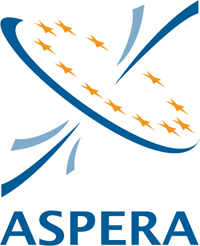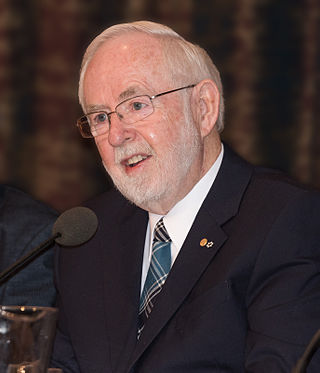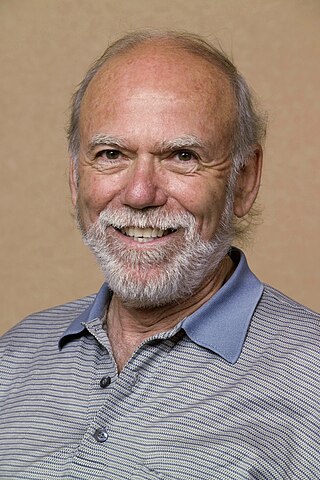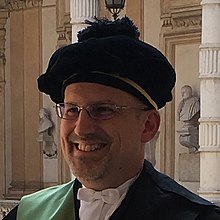Weakly interacting massive particles (WIMPs) are hypothetical particles that are one of the proposed candidates for dark matter.
The Max-Planck-Institut für Kernphysik is a research institute in Heidelberg, Germany.
Astroparticle physics, also called particle astrophysics, is a branch of particle physics that studies elementary particles of astronomical origin and their relation to astrophysics and cosmology. It is a relatively new field of research emerging at the intersection of particle physics, astronomy, astrophysics, detector physics, relativity, solid state physics, and cosmology. Partly motivated by the discovery of neutrino oscillation, the field has undergone rapid development, both theoretically and experimentally, since the early 2000s.
Alexei Yuryevich Smirnov is a neutrino physics researcher and one of the discoverers of the MSW Effect.

ASPERA is a network of national government agencies responsible for coordinating and funding national research efforts in astroparticle physics.

Arthur Bruce McDonald, P.Eng is a Canadian astrophysicist. McDonald is the director of the Sudbury Neutrino Observatory Collaboration and held the Gordon and Patricia Gray Chair in Particle Astrophysics at Queen's University in Kingston, Ontario from 2006 to 2013. He was awarded the 2015 Nobel Prize in Physics jointly with Japanese physicist Takaaki Kajita.

Geraint Francis Lewis is a Welsh astrophysicist, who is best known for his work on dark energy, gravitational lensing and galactic cannibalism. Lewis is a Professor of Astrophysics at the Sydney Institute for Astronomy, part of the University of Sydney's School of Physics. He is head of the Gravitational Astrophysics Group. He was previously the Associate Head for Research at the School of Physics, and held an Australian Research Council Future Fellowship between 2011 and 2015. Lewis won the 2016 Walter Boas Medal in recognition of excellence in research in Physics. In 2021, he was awarded the David Allen Prize of the Astronomical Society of Australia for exceptional achievement in astronomy communication.
Manfred Lindner is a German physicist and director at the Max Planck Institute for Nuclear Physics in Heidelberg, Germany. He conducts basic research in particle and astro-particle physics.

Padma Kant Shukla was a distinguished Professor and first International Chair of the Physics and Astronomy Department of Ruhr-University Bochum in Germany. He was also the director of the International Centre for Advanced Studies in Physical Sciences at Ruhr-University Bochum. He held a Ph.D. in Physics from Banaras Hindu University in Varanasi, India and a second doctorate in Theoretical Plasma Physics from Umeå University in Sweden.

Ivan Aničin, was Yugoslav and Serbian nuclear physicist, particle physicist, astrophysicist, and cosmologist, university Full Professor and Distinguished (teaching/research) Professor of scientific institutes in Belgrade (Serbia), Bristol, Grenoble (France), and Munich (Germany).

Stavros Katsanevas was a Greek-French astrophysicist who was director of the European Gravitational Observatory, professor at the Université Paris Cité, former director of the AstroParticle and Cosmology (APC) laboratory and former chairman of the Astroparticle Physics European Consortium (APPEC). In 2000, he received for his work on supersymmetry the Physics Prize from the Academy of Athens. In 2011, he was awarded the Ordre National du Merite. He was an ordinary member of Academy of Europe, Earth and Cosmic Sciences since 2019.

Barry Clark Barish is an American experimental physicist and Nobel Laureate. He is a Linde Professor of Physics, emeritus at California Institute of Technology and a leading expert on gravitational waves.

The China Jinping Underground Laboratory is a deep underground laboratory in the Jinping Mountains of Sichuan, China. The cosmic ray rate in the laboratory is under 0.2 muons/m2/day, placing the lab at a depth of 6720 m.w.e. and making it the best-shielded underground laboratory in the world. The actual depth of the laboratory is 2,400 m (7,900 ft), yet there is horizontal access so equipment may be brought in by truck.
Ramanath Cowsik is an Indian astrophysicist and the James S. McDonnell Professor of Space Sciences at Washington University in St. Louis. He is considered by many as the father of astroparticle physics. A recipient of the Shanti Swarup Bhatnagar Prize, Cowsik was honored by the Government of India, in 2002, with the fourth highest Indian civilian award of Padma Shri
Joakim Edsjö is a Swedish professor of theoretical physics at Stockholm University. His research is carried out at the interface of particle physics, astrophysics and cosmology, and is particularly concerned with the search for dark matter.
Biswarup Mukhopadhyaya is an Indian theoretical high energy physicist and a senior professor at Indian Institute of Science Education and Research, Kolkata. Known for his research on High energy colliders, Higgs bosons, neutrinos, Mukhopadhyaya is an elected fellow of the National Academy of Sciences, India. The Council of Scientific and Industrial Research, the apex agency of the Government of India for scientific research, awarded him the Shanti Swarup Bhatnagar Prize for Science and Technology, one of the highest Indian science awards, for his contributions to physical sciences in 2003.
Marica Branchesi is an Italian astrophysicist. Her leadership and scientific work was pivotal for Virgo/LIGO's discovery of gravitational waves. She is vice president of International Astronomical Union Gravitational Wave Astrophysics Commission and member of the Gravitational Wave International Committee.

Dharam Vir Ahluwalia is an Indian-born American theoretical physicist who has made significant contributions to physics of neutrino oscillations, gravitationally induced phases, interface of the gravitational and quantum realms, and mass dimension one fermions. In 2019 he published Mass Dimension One Fermions.
Graciela Beatriz Gelmini is a theoretical physicist who specializes in astroparticle physics. She is a professor at the University of California, Los Angeles (UCLA), and became a fellow of the American Physical Society in 2004.
Teresa Montaruli is an Italian astronomer specializing in neutrino astronomy, and in particular in the search for high-energy neutrinos from cosmic sources. She is a professor in the particle physics department at the University of Geneva.









